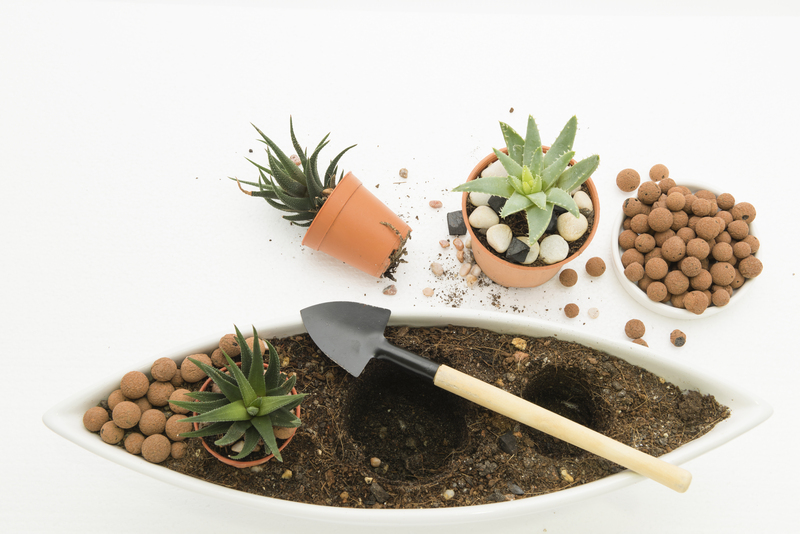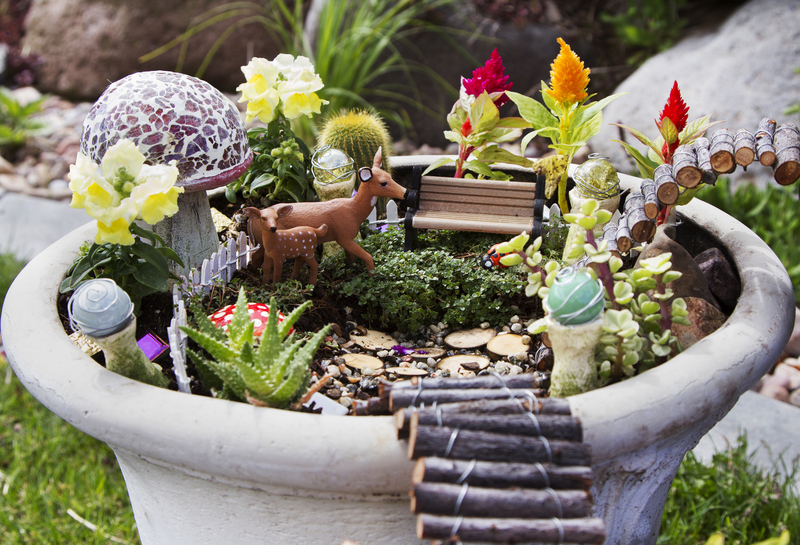Creating a Weather-Savvy Garden to Withstand Storms
Posted on 17/09/2025
Creating a Weather-Savvy Garden to Withstand Storms
In an era of increasingly unpredictable weather patterns, designing a resilient garden is essential for both passionate gardeners and those newly interested in sustainable landscapes. Gardens not only beautify spaces but also play a role in local ecosystems. However, severe storms, including heavy rain, strong winds, hail, and flooding can jeopardize your hard work and investment. How can you create a weather-savvy garden that thrives after the storm has passed? This comprehensive guide explores actionable strategies to make your garden withstand storms, safeguard your plants, and ensure your landscape remains flourishing year after year.
Why Resilient Gardens Matter More Than Ever
Climate change is bringing more frequent and severe weather events that challenge conventional gardening. Homeowners are now seeking storm-resistant gardening solutions to minimize losses and protect the environment. From soil erosion to plant breakage, storm damage can be extensive--but it's not inevitable. By embracing smart planning and sustainable practices, you can build a truly weatherproof garden that bends, but doesn't break.

1. Assessing Your Garden's Vulnerability
Before choosing storm-proof plants or building windbreaks, you need to understand the risks unique to your landscape. Here's how to start:
- Examine garden orientation: Take note of which directions the winds typically blow and where water pools after rain.
- Assess drainage and soil type: Clay-heavy soils hold water, risking root rot; sandy soils may let water run off too quickly.
- Identify microclimates: Tall buildings, fences, and slopes create zones more or less susceptible to wind and flooding.
A thorough assessment allows you to customize your weather-savvy garden strategy--a key step to storm-resistant landscaping.
2. Soil Preparation: The Foundation of a Storm-Resistant Garden
Storms challenge soil integrity through erosion, compaction, and waterlogging. To protect your garden beds and support plant health:
- Add organic matter: Compost and well-rotted manure improve soil structure, aiding both water absorption and drainage.
- Use mulch: Apply a generous layer of organic mulch to reduce runoff, hold moisture, and prevent soil splashing onto plants.
- Install raised beds: Raised beds help control drainage, keeping roots safe from sudden downpours or floods.
- Test soil regularly: Use a test kit to monitor pH and nutrient levels, correcting imbalances before storms amplify problems.
Bonus Tip: Mulch Wisely
After a storm, remove any mulch that has been washed away or contaminated. Replenish as necessary to maintain your weather-ready garden.
3. Selecting Storm-Resistant Plants for Your Weather-Savvy Garden
Plant selection is pivotal in creating a weather-hardy landscape. Opt for species that are:
- Deep-rooted: Trees and shrubs with deep roots anchor soil and resist being uprooted by wind or water.
- Flexible: Willowy or flexible-stemmed plants fare better in high winds than brittle varieties.
- Native: Native species are adapted to local weather extremes and have better survival rates post-storm.
- Salt- and flood-tolerant: If you're in a coastal or flood-prone area, prioritize plants that can survive saline or saturated soils.
Examples of weather-tough plants: Little bluestem, switchgrass, coneflower, oakleaf hydrangea, serviceberry, live oak, and wax myrtle.
Group Plantings for Maximum Resilience
Planting in groups or clusters provides mutual shelter, reducing wind-loading on individual stems and making your garden landscape more cohesive and sturdy.
4. Building Windbreaks and Strategic Barriers
Wind is a powerful destructive force in storms. Smart garden design uses natural and artificial barriers to redirect or break up wind, lessening its impact.
- Plant layered windbreaks: Use staggered rows of trees and shrubs to slow wind speed. Evergreens offer year-round protection.
- Install hedges or fencing: Permeable materials (such as slatted wooden fences or living hedges) are better than solid barriers, which can be toppled or cause wind turbulence.
- Position barriers intelligently: Place windbreaks on the windward side (typically the northwest) of your property for maximum efficacy.
Over time, these features enhance microclimate stability, providing not just storm protection but also habitat for beneficial wildlife.
5. Thoughtful Water Management for Heavy Rains and Floods
Rainfall intensity is increasing globally, putting gardens at risk of both temporary flooding and chronic wetness. Robust water management is a core component of a weather-resistant garden:
- Build swales and rain gardens: These landscaped depressions collect and slow runoff, allowing water to soak in rather than pooling around roots.
- Use permeable paving: Gravel, permeable pavers, or open-joint bricks reduce runoff and encourage groundwater recharge.
- Install rain barrels: Capture roof runoff for later use, relieving stress on overloaded drains and conserving water resources.
- Direct downspouts intelligently: Point them away from vulnerable beds and toward rain gardens or grassy zones.
*Clever water management not only reduces storm damage but also improves drought resilience--making your garden doubly adaptable!*
6. Protect Garden Structures and Accessories
Storms don't only threaten your plants. Garden buildings, fences, and even decorative elements are at risk. For a truly weather-savvy and storm-safe garden, don't forget to:
- Secure sheds and greenhouses: Anchor structures deeply. Inspect frames and roofs annually for loose fittings.
- Store lightweight items: Bench seats, tools, and plant pots can become dangerous missiles in high winds--secure or store them before severe weather is forecast.
- Use storm-resistant materials: Choose metals and woods treated for UV and water resistance.
- Prune overhanging limbs: Regularly trim back tree branches that could damage roofs, windows, or power lines.
*Safety first: Always check your garden structures after a storm to ensure no latent hazards such as loose components or structural instability.*
7. Emergency Storm-Prep Tips for Gardeners
Even the most storm-ready gardens need a last-minute action plan when severe weather warnings are issued:
- Stake tall or young plants: Use sturdy stakes and soft ties to secure them against wind damage.
- Move container plants: Place pots in sheltered nooks or indoors if temps allow.
- Harvest ripe produce: Collect fruits and vegetables before a storm hits to avoid losses.
- Shut greenhouses and cold frames: Double-check fastenings and latches.
- Lay coverings: Use floating row covers or cloches to shelter delicate seedlings from hail.
8. Post-Storm Recovery: How to Revitalize Your Garden
Once the storm passes, swift action can make the difference between recovery and long-term damage. Here's what to do:
- Survey the entire garden: Look for standing water, broken branches, and uprooted plants.
- Remove debris promptly: Clear leaves, branches, and any contaminated mulch to reduce disease risk.
- Prune judiciously: Cut back damaged stems to healthy growth; don't prune too much at once, which stresses plants further.
- Replant or stake as needed: Upright fallen plants and re-firm the soil, staking if necessary.
- Check for pests and disease: Storms create wounds on plants, which can be entry points for infection.
Assess And Amend the Soil
Heavy rain can deplete nutrients and compact the soil. Once the ground dries, gently aerate soil and add compost or fertilizer as needed.
Keep a Watchful Eye
Ongoing observation ensures your storm-resistant garden remains healthy through the changing seasons. Log what worked and what didn't--every storm is a learning opportunity!
9. Beyond the Backyard: Environmental Benefits of Storm-Hardy Gardens
Creating a weather-adaptive landscape not only benefits your property but also offers broad ecological advantages:
- Reduces urban flooding: Healthy gardens absorb more rainwater, helping manage run-off in neighborhoods.
- Prevents soil erosion: Well-rooted plantings and mulched beds keep precious topsoil in place.
- Supports pollinators and wildlife: Native, storm-hardy species create habitat after weather events when resources are scarce.
- Stores carbon: Thriving vegetation captures and holds more carbon, fighting climate change.
A weather-savvy, storm-resistant garden is a powerful tool in building greener, safer communities. Encourage neighbors to adopt similar practices for even greater impact!
10. Frequently Asked Questions About Weather-Savvy Gardening
What are the best plants for a storm-resistant garden?
Each climate zone has different "storm survivors." In general, choose deep-rooted natives adapted to your region's weather extremes. Flexible grasses, sturdy shrubs, and small-leafed trees often fare better than fast-growing, shallow-rooted species.
How can I prevent my garden from flooding?
Amend your soil with organic matter, use rain gardens, and maintain proper drainage. Avoid compacting soil, and make use of raised beds in very soggy areas.
How do I prepare for storms if I have limited time?
Move vulnerable pots to shelter, secure or store loose items, and harvest produce. Stake young or tall plants in advance and double-check that all structures are stable.

11. Final Thoughts: The Lifelong Value of a Storm-Ready Garden
A storm-proof garden isn't achieved overnight. It evolves through thoughtful planning, observation, and adaptation. Every storm offers lessons, making you a more intuitive, resourceful gardener. By adopting cultural practices, choosing storm-tough plants, and strategically designing your space, you'll build a garden that weathers storms--and emerges stronger each season.
Start today. Assess your landscape, select resilient species, and implement weather-wise garden practices. Together, let's cultivate gardens that are as resilient as they are beautiful--for your enjoyment and for generations to come.
Key Takeaways: Building a Garden Designed for the Weather
- Understand your site's unique risks before planting.
- Build healthy, well-draining soil.
- Select flexible, native, storm-resistant plants.
- Design windbreaks and water-smart features.
- Protect garden structures and have a storm readiness plan.
- Act quickly after storms to promote recovery.
Your garden can be your sanctuary--even in nature's roughest weather. Follow these steps for a truly weather-savvy and storm-resistant garden that endures, inspires, and sustains.

